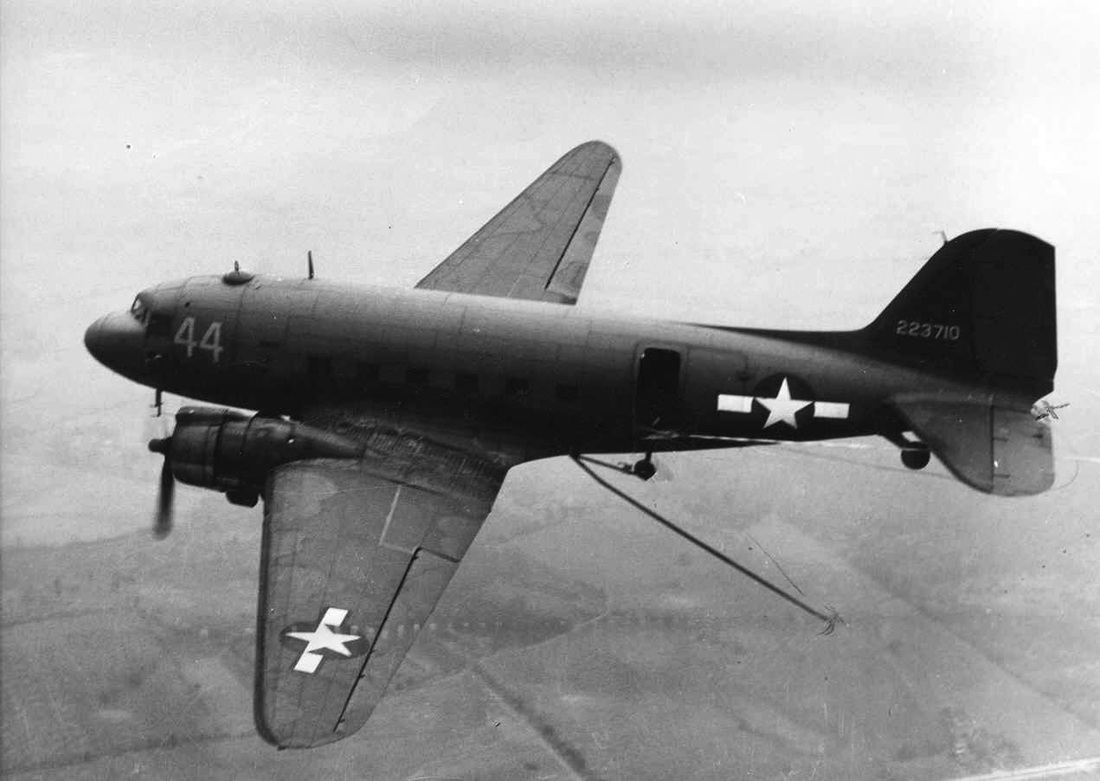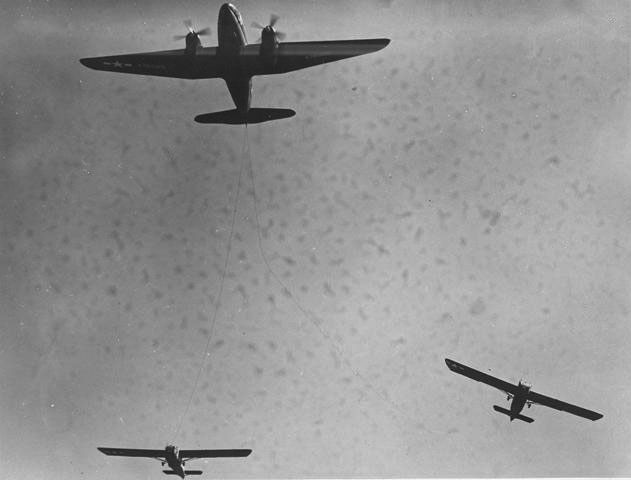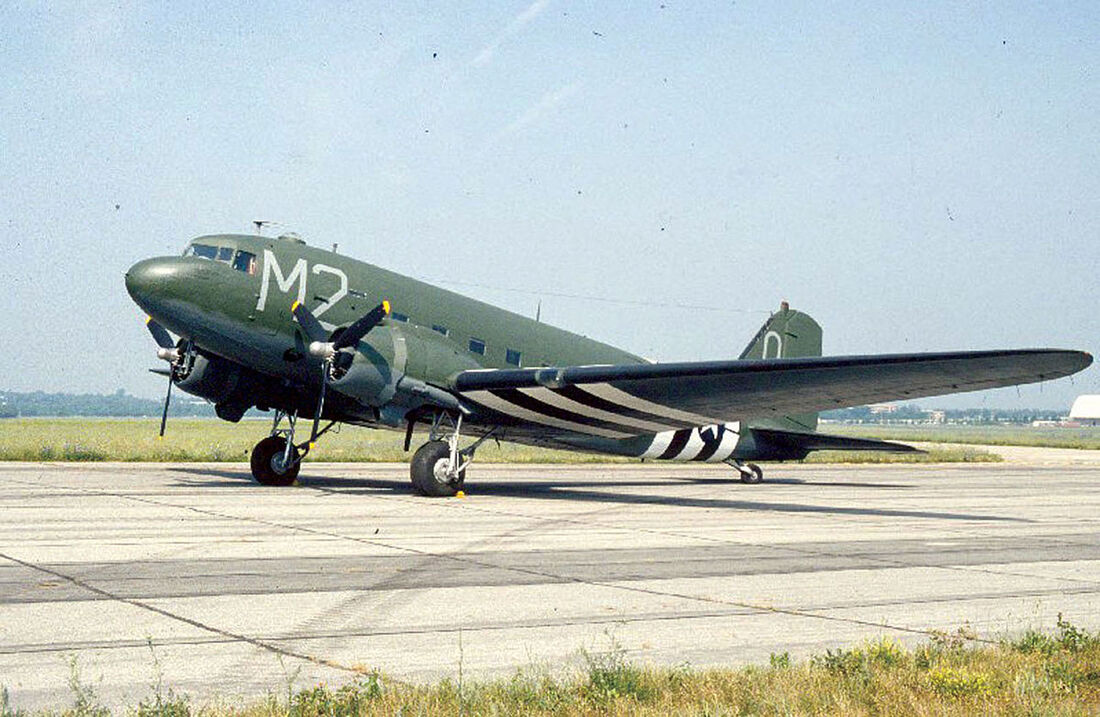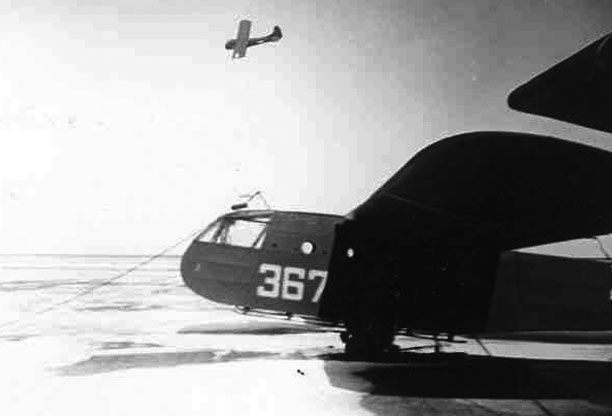The WWII Glider Pilots
There is very little pictorial history and artifacts of the WWII era glider activity at the Atterbury Army Air Field and we need your help finding photographs, memorabilia and personal stories about this great time in history. Contact the museum if you can help. Also, if you can help identify the dates, locations, and people in some of our photos, please let us know.
MORE PAGES
Learn more about glider pilot training here >
Learn more about glider pilots in England and France during WWII here >
Learn more about glider pilot training here >
Learn more about glider pilots in England and France during WWII here >
Many WWII CG-4A Glider artifacts, one eighth scale CG-4A , and a CG-4A Glider nose in can be seen at the Atterbury-Bakalar Air Museum.
A rare color photograph of CG-4A gliders in tow. From the markings and numbers on the gliders, they do not appear to be from Atterbury Army Air Field. This photo was found in the museum archives. Two photos from Atterbury Army Air Field show the number 10 and 50 and Troop Carrier insignia on those gliders stationed at the former base. Chris Rumley, the 314th AW historian recently talked with some individuals in Stuttgart , Arkansas who stated the photo may have been taken near the old Stuttgart Army Air Base. The ground below looks like harvested rice fields and bean fields, which are common in that area. Gliders trained at the air base. This information is offered as a possible location of the photo.
This photo has the names Sgt. Fielding and Big "Chief" noted on it, taken at Atterbury Army Air Field during 1945.
The name Radanke was on this photo of a CG-4A at Atterbury Army Air Field taken 1945.
CG-4A #50 on the ramp at Atterbury Army Air Field with unknown pilot standing next to the glider.
A photo taken from a CG-4A toward the C-47 tow aircraft.
Another photo looking west over Atterbury Army Air Field during 1945.
Wayne Palm standing next to a CG-4A Glider.
A snapshot taken from the cockpit of a CG-4A Glider as the C-47
lifts off during the take off sequence of the two aircraft.
lifts off during the take off sequence of the two aircraft.
Another CG-4A on a long tow appears to be taken from another glider in tow.
We are unsure of the location of these two photos. The back of them are stamped "Official Photo Army Air Forces George Field, ILL." The notation on the first states "Short tow glider cutting loose" and on the bottom photo, "Emergency Snatch pick up" and the photo has 805AB-29 Apr. 45-L83-Openhouse noted on it.
CG-4A Specifications
A U.S. Army Air Force Waco CG-4A-GN glider (s/n 45-27948) at the National Museum of the United States Air Force, at Dayton, Ohio (USA). View original image here.
Span: 83 ft. 8 in.
Length: 48 ft. 4 in.
Height: 12 ft. 7 in.
Weight: 7,500 lbs. loaded
Armament: None
Engine: None
Cost: $24,000
PERFORMANCE
Maximum towed speed: 150 mph.
Span: 83 ft. 8 in.
Length: 48 ft. 4 in.
Height: 12 ft. 7 in.
Weight: 7,500 lbs. loaded
Armament: None
Engine: None
Cost: $24,000
PERFORMANCE
Maximum towed speed: 150 mph.
C-47 SPECIFICATIONS
A U.S. Army Air Force C-47D Skytrain at the National Museum of the United States Air Force, at Dayton, Ohio (USA). View original image here.
Span: 95 ft. 0 in.
Length: 64 ft. 5 in.
Height: 16 ft. 11 in.
Weight: 33,000 lbs. loaded
Armament: None
Engines: Two Pratt & Whitney R-1830s of 1,200 hp. ea.
Crew: Six
Cost: $138,000
PERFORMANCE
Maximum speed: 232 mph.
Cruising speed: 175 mph.
Range: 1,513 miles
Service Ceiling: 24,450 ft.
Span: 95 ft. 0 in.
Length: 64 ft. 5 in.
Height: 16 ft. 11 in.
Weight: 33,000 lbs. loaded
Armament: None
Engines: Two Pratt & Whitney R-1830s of 1,200 hp. ea.
Crew: Six
Cost: $138,000
PERFORMANCE
Maximum speed: 232 mph.
Cruising speed: 175 mph.
Range: 1,513 miles
Service Ceiling: 24,450 ft.
These two Official Army Air Force photographs were taken by the Base Photo Section, Bowman Field, Kentucky, during WWII. A C-47 makes a 120 MPH pick up of a fully loaded CG-4A Glider and a successful pick-up is made by the Troop Carrier Command aircraft. As an auxiliary of Bowman Field, Atterbury Army Air Base assisted the Troop Carrier Command in training pilots.
Glider Pilot training was conducted at the Atterbury Army Airfield during 1944 and 1945. In March of 1944, liaison type airplanes arrived at Atterbury Army Airfield from Bowman Field, Kentucky for the glider pilot training program. The small planes with their motors shut off give the filers practice identical to landing a glider.
In June 1944, several gliders arrived at the air field and were the first reported at the field. Also, on June 19, 1944 a glider landed in a cow pasture east of the airfield on the Marr farm. The glider was snatched from the field the next day by a C-47 in an air-ground "close line snatch." An experienced C-47 pilot and glider pilot from Stout Field at Indianapolis were called upon to make the pick-up. A jeep pulled the glider to the corner of the field and a tow line was laid out in front of the glider and stretched across two vertical poles about 12 feet high. It took four tries for the C-47 pilot to pick up the glider. It became a common site around the area for gliders to make unscheduled stops in farm fields.
Full-scale glider operations got under way on March 3, 1945. Atterbury Army Air Field commander Major Robert E. McDonald announced that it would be the center for all glider operations in connection with the training of Troop Carrier Command pilots at George Field. George Field was northwest of Vincennes, Indiana in Illinois. Atterbury Army Air Field was also used for practice take off and landing by C-47 and C-46 transports.
Glider training continued after V-J Day during 1945. On February 7, 1946, high winds sent eight old gliders on their last flight. The gliders were all retired to the salvage section of the field when caught by the wind. The wind gusts reached 50 miles an hour at times as recorded at the field. The normal take off speed of a glider is 40 miles an hour and when hit by the gusts they began flying.
This information was supplied by Bruce Dalton of Columbus, a WWII Glider Pilot, from articles researched in past editions of the Columbus newspaper. Bruce was active with the museum staff and had vast knowledge of CG4A Gliders. Bruce passed away in 2007.
Glider Pilot training was conducted at the Atterbury Army Airfield during 1944 and 1945. In March of 1944, liaison type airplanes arrived at Atterbury Army Airfield from Bowman Field, Kentucky for the glider pilot training program. The small planes with their motors shut off give the filers practice identical to landing a glider.
In June 1944, several gliders arrived at the air field and were the first reported at the field. Also, on June 19, 1944 a glider landed in a cow pasture east of the airfield on the Marr farm. The glider was snatched from the field the next day by a C-47 in an air-ground "close line snatch." An experienced C-47 pilot and glider pilot from Stout Field at Indianapolis were called upon to make the pick-up. A jeep pulled the glider to the corner of the field and a tow line was laid out in front of the glider and stretched across two vertical poles about 12 feet high. It took four tries for the C-47 pilot to pick up the glider. It became a common site around the area for gliders to make unscheduled stops in farm fields.
Full-scale glider operations got under way on March 3, 1945. Atterbury Army Air Field commander Major Robert E. McDonald announced that it would be the center for all glider operations in connection with the training of Troop Carrier Command pilots at George Field. George Field was northwest of Vincennes, Indiana in Illinois. Atterbury Army Air Field was also used for practice take off and landing by C-47 and C-46 transports.
Glider training continued after V-J Day during 1945. On February 7, 1946, high winds sent eight old gliders on their last flight. The gliders were all retired to the salvage section of the field when caught by the wind. The wind gusts reached 50 miles an hour at times as recorded at the field. The normal take off speed of a glider is 40 miles an hour and when hit by the gusts they began flying.
This information was supplied by Bruce Dalton of Columbus, a WWII Glider Pilot, from articles researched in past editions of the Columbus newspaper. Bruce was active with the museum staff and had vast knowledge of CG4A Gliders. Bruce passed away in 2007.
Bruce Dalton and the Atterbury-Bakalar Air Museum CG-4A Glider Nose Project and Scale Glider featured in the Hoosier Times/Herald Times Newspaper.
On display at the Atterbury-Bakalar Air Museum are CG-4A Glider parts donated by Glen Russo of Clifton New Jersey. Thanks to Glen, the museum has glider bench seats, escape hatch, jump seat, and seat backs. These items were found in the attic of a farm house in the Pocono Mountains in Pennsylvania. In the photograph above, you can see how the bench seats and seat backs were used in the glider.
L-4 Liaison Aircraft
L-4 Liaison Aircraft used for glider pilot training at Atterbury Army Air Force Base. The engine was shut down for gliding training. It was also used for flight time for the glider pilots and sometimes it was used as an aerial taxi cab flown between Bowman Field, Louisville, Kentucky and Atterbury Army Air Field.
The TG-3A
The TG-3A is a two-place, dual control glider manufactured by the Schweizer Aircraft Company for the Army Air Force during WWII. Students received about six hours dual instruction in the TG-3A before being trained in the CG-4A cargo glider.
photos donated by david e. filer family
|
The following group of photos was donated to the museum, along with uniforms, ribbons, correspondence, and other artifacts, by Melinda Filer Easley and Pamela Thomas, daughters of World War II Glider Pilot David E. Filer. These great photos show the daily life of a WWII glider pilot: the uniforms, equipment, locations, and most importantly, the people. Many of the snapshots were taken during Glider Training. Museum Volunteer and former WWII Glider Pilot Bruce Dalton can be seen in some of these photos, along with David Filer.
Without the former service members or their families donating these one-of-a-kind historical photographs, equipment, documents, and artifacts to our museum, you would not be able to view them, and they would be lost to history. |
From top to bottom, the photos below show the interior of the Glider Pilots barracks at a training site, and various photos of gliders during training. Many of the photos had "Place Studios division of The Goodeve Company Lubbock Texas" stamped on the back.
David E. Filer
The view from the cockpit of a CG-4A glider and the C-47 towing the glider.
A glider landing, note the tail still airborne.
Photo taken from the cockpit of another glider that just landed.
The uniform of the day for the Glider Pilot.
David Filer, the shortest in the photo facing the camera, and
Bruce Dalton on the right side of the photo with his back turned to the camera.
Bruce Dalton on the right side of the photo with his back turned to the camera.
In this photo, David and Bruce are in the center of the photo.
In this photo, an L-4 aircraft can be seen and Bruce Dalton
is sixth from the left, back row just under the wing tip.
is sixth from the left, back row just under the wing tip.
Tent City with a soldier shaving shows some of the Glider Pilot's living conditions.
A CG-4A being worked on.
The pilot's lounge in England, where they were censoring mail.
A street scene in England.
The museum is always looking for WWII glider artifacts, particularly from the former Atterbury Army Air Field. Contact the museum if you have anything you wish to donate associated with the W.W.II Glider Pilots.













































